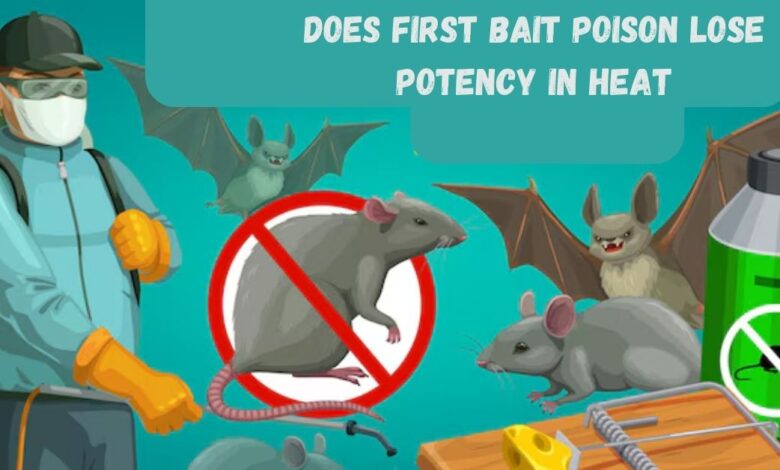Does First Bait Poison Lose Potency in Heat?

Using bait poisons effectively to control pests like rodents and insects requires understanding the factors that may affect their potency, including environmental conditions. When asking, does first bait poison lose potency in heat, it’s important to know that temperature, particularly high heat, can significantly impact bait poison effectiveness. Understanding how heat influences the potency of these substances is essential for anyone looking to manage pest control effectively, especially in warm climates. This article explores the science behind bait poison efficacy, examines how heat exposure might reduce their effectiveness, and offers insight into best practices for storage and usage.
What is Bait Poison and How Does It Work?
Bait poison is a substance that attracts pests like rodents, cockroaches, ants, and other common nuisances, allowing for effective control. The bait combines a food-based attractant with a toxic substance that, once ingested, leads to the pest’s death. Different types of bait poisons are available on the market, targeting specific pests, but all generally rely on the same principle: attract, consume, and eliminate.
To ensure success, bait poisons need to maintain their potency over time. Potency refers to the strength or concentration of the toxic component within the bait, which needs to be sufficient to kill pests even when only a small amount is ingested. For this reason, many consumers and pest control professionals are concerned about whether environmental factors like heat can diminish the poison’s efficacy.
Does first bait poison lose potency in heat?
Heat has a well-known effect on many chemicals, potentially altering their structure and effectiveness. Bait poisons, being chemically formulated, can be vulnerable to high temperatures. Under certain conditions, heat may cause bait poisons to lose some or all of their potency, rendering them less effective or even ineffective. The degree of potency loss will depend on the type of poison, its ingredients, and the conditions under which it is stored or used.
Understanding how heat impacts bait poisons involves a closer look at the components of these products. Some common active ingredients in bait poisons include:
- Anticoagulants: These compounds are used to target rodents, causing internal bleeding after ingestion. Common anticoagulants in rodenticides include warfarin and bromadiolone.
- Neurotoxins: These are used against a wide range of pests and work by disrupting their nervous systems, leading to paralysis and death. Examples include indoxacarb and fipronil.
- Insect growth regulators (IGRs): IGRs prevent insects from reaching maturity, reducing reproduction rates in pest populations. Examples include methoprene and pyriproxyfen.
Each of these chemicals can respond differently to heat, and their potency might degrade over time if exposed to temperatures above recommended levels.
How Heat Impacts Chemical Composition in Bait Poisons
Does first bait poison lose potency in heat? Heat can indeed lead to a process called chemical degradation, where the chemical bonds in a substance break down over time. With first bait poison, this degradation process can accelerate when exposed to temperatures beyond what the product was designed to withstand. This chemical degradation may lead to reduced potency, meaning the bait poison becomes less effective in killing pests.
For example, if the active ingredient in a bait is a compound that is sensitive to heat, exposure to high temperatures may weaken its toxic effects. This makes it less effective in managing pest populations. While some active ingredients are more resilient, others, such as anticoagulants, can be particularly vulnerable to heat and humidity.
Additionally, high temperatures can change the consistency or texture of bait poisons, which can influence whether pests will consume them. If a bait hardens, dries out, or develops an unusual smell due to heat exposure, pests may avoid it altogether, further diminishing the product’s effectiveness.
The Role of Humidity Alongside Heat
While heat is a major factor in the degradation of bait poisons, humidity can also play a role, especially when the two factors are combined. High humidity can cause bait to become sticky or moldy, which can reduce its attractiveness to pests. In certain cases, humidity can also lead to faster degradation of the active ingredient, compounding the impact of heat.
Rodenticide blocks, gel baits, and other forms of bait that rely on a food-like substance to attract pests are especially vulnerable to humidity, which can cause mold to grow on the bait, deterring pests from ingesting it. To ensure bait poisons remain attractive to pests and retain their potency, they should be kept in low-humidity environments and out of direct heat as much as possible.
Recommended Storage Conditions for Bait Poisons
Manufacturers typically provide recommended storage conditions on bait poison packaging to help preserve product potency. These recommendations often specify storing bait poisons in cool, dry locations away from direct sunlight and moisture. Following these guidelines is essential for anyone using bait poisons, as incorrect storage can lead to the rapid degradation of the product’s effectiveness.
Here are some general guidelines for storing bait poisons to maintain potency:
- Store in a Cool Environment: Avoid places where temperatures can rise above room temperature, such as in direct sunlight or near heat-producing appliances.
- Keep in a Dry Place: Humidity can alter the physical state of bait poisons, making them less attractive to pests.
- Use Airtight Containers: This can prevent moisture from entering and can also reduce any odor changes due to exposure to air.
- Avoid Extreme Temperature Fluctuations: Places that fluctuate between hot and cold can accelerate degradation, particularly with certain types of chemical compounds.
Practical Considerations for Outdoor Baiting in Hot Climates
Outdoor baiting is often necessary for pests like rats, mice, and insects that thrive in warmer climates. However, the risk of potency loss due to heat is a significant concern when bait poisons are placed outdoors. In areas with high daytime temperatures, it’s essential to consider the following practices:
- Timing of Bait Placement: Place baits during cooler parts of the day, such as early morning or late evening. This reduces direct exposure to high temperatures.
- Use Bait Stations: Bait stations provide shade and shelter from direct sunlight, which can help minimize heat exposure to bait poisons.
- Frequent Replacement: In extreme heat, replace baits more frequently to ensure they remain potent and attractive to pests.
- Avoid Reflective Surfaces: Bait placed on or near metal or glass surfaces can experience increased temperatures due to sunlight reflection, which can speed up the degradation process.
Signs that Bait Poison Has Lost Its Potency
It can be challenging to determine whether bait poison has lost its potency just by looking at it. However, there are a few indicators that can signal that the product may no longer be effective:
- Unusual Appearance: Changes in color, consistency, or texture can indicate chemical degradation.
- Lack of Pest Activity: If pests continue to frequent an area despite the presence of bait, it may have lost potency or effectiveness.
- Foul Smell: Some bait poisons may develop an unusual or rancid smell after being exposed to high heat, making them less appealing to pests.
If any of these signs are present, it may be time to replace the bait with a fresh, properly stored product to ensure continued efficacy in pest control efforts.
Does All Bait Poison Lose Potency in Heat?
Not all bait poisons are equally susceptible to potency loss due to heat. The type of active ingredient and its chemical stability play a major role in determining how resilient a product is to high temperatures. For instance:
- Boric Acid-Based Products: Boric acid, a common insecticide, tends to be more heat-stable compared to some other toxic compounds and can maintain potency even in warmer environments.
- Gel Baits: Gel baits used for ants or cockroaches may not degrade as quickly in heat as some rodenticides but can still dry out and become unappealing to pests.
- Wax Blocks: Some rodenticides are manufactured as wax blocks, which can withstand higher temperatures than softer bait types, although they may still soften in extreme heat, affecting palatability.
Each product’s stability will depend on the formulation and the specific conditions it is exposed to, so it’s important to read product labels and consult with pest control professionals if unsure.
How to Ensure Effective Pest Control in Hot Environments
For those living in warm climates, where high temperatures are a constant concern, there are additional strategies to ensure effective pest control:
- Consider Heat-Resistant Options: Some products are specifically formulated to withstand higher temperatures. Consult product labels or talk to a pest control professional to identify heat-resistant options.
- Use Alternative Methods: Mechanical traps, sticky traps, or non-chemical methods may be more effective in extremely hot environments where chemical baits quickly degrade.
- Regularly Inspect Bait Sites: Check bait stations frequently in hot weather to ensure the product is in good condition and replace as needed.
- Consult Pest Control Experts: They can provide recommendations based on local climate conditions and help determine the best bait type for the environment.
Conclusion
Does first bait poison lose potency in heat? Heat can indeed affect the potency of bait poisons, with high temperatures potentially causing chemical degradation, changes in bait consistency, and diminished attractiveness to pests. To ensure effective pest control, it’s crucial to store bait poisons in a cool, dry place and replace them frequently in warm climates. By understanding how heat influences the efficacy of these products, users can take proactive measures to maintain bait potency and achieve reliable pest control, regardless of environmental conditions.



